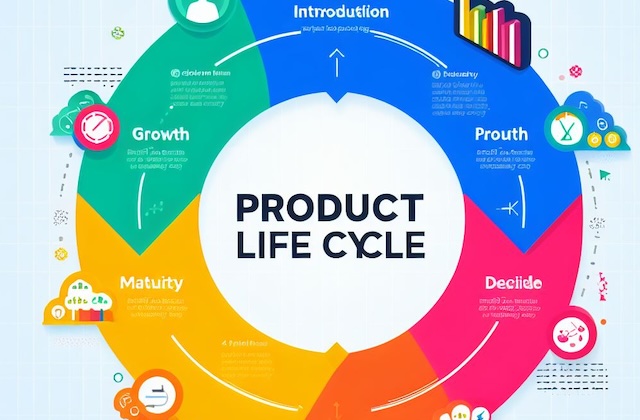
Life Cycle
“The most powerful tool in a product manager’s toolkit is empathy for the customer.”
– Melissa Perri
Welcome to Day 23 of the PM series – Product Management in 30 Days!
In the dynamic world of product management, achieving success isn’t merely about launching a product; it’s about meticulously crafting a strategy that guides that product through its entire lifecycle. Product Lifecycle Management (PLM) is the key that unlocks the door to sustained success. We will delve into the intricacies of PLM, exploring how it influences every aspect of a product’s journey.
Learning Objectives
- Understanding the Concept of Product Life Cycle: Define the product life cycle and recognize its stages. Identify the key characteristics and challenges associated with each stage of the product life cycle.
- Importance of Product Life Cycle Management (PLM): Understand the significance of PLM in maximizing a product’s potential throughout its life cycle. Recognize how effective PLM contributes to sustained market relevance and profitability.
- Key Strategies in Product Life Cycle Management: Explore essential strategies for managing products at different life cycle stages. Learn how to adapt marketing, pricing, and innovation strategies based on the specific needs of each life cycle phase.
- Application of PLM in Real-World Scenarios: Examine case studies or real-world examples illustrating successful implementations of PLM. Understand how companies navigate challenges and capitalize on opportunities at various stages of the product life cycle.
- Tools and Technologies in PLM: Familiarize yourself with the tools and technologies used in modern PLM practices. Learn how digital solutions, data analytics, and collaboration platforms enhance efficiency in product life cycle management.
Product LifeCycle Concept
Understanding the concept of the product life cycle (PLC) is foundational for effective product management. The product life cycle represents the journey a product undergoes from its introduction to the market until its eventual decline. This life cycle is typically divided into several stages, each characterized by distinct attributes and challenges.

Introduction Stage:
- Characteristics: In this stage, a new product is introduced to the market. Sales are initially slow as consumers become aware of the product.
- Challenges: High marketing and development costs, coupled with low sales volume, are common challenges.
Growth Stage:
- Characteristics: Sales start to grow rapidly as the product gains acceptance. Profits increase, and competitors enter the market.
- Challenges: Maintaining market share amid growing competition becomes crucial, and pricing strategies play a significant role.
Maturity Stage:
- Characteristics: Sales peak, and the market reaches saturation. The competition is fierce, and product differentiation is vital.
- Challenges: Sustaining customer interest, managing competition, and exploring new markets become key challenges.
Decline Stage:
- Characteristics: Sales decline due to changing consumer preferences, technological advancements, or market saturation.
- Challenges: Companies may decide whether to maintain, harvest, or discontinue the product. Effective cost management becomes crucial.
Understanding these stages allows product managers to tailor strategies, allocate resources wisely, and make informed decisions at each phase of the product’s life. Recognizing the challenges and opportunities unique to each stage empowers product managers to navigate the complexities of the product life cycle successfully.
Importance of Product Life Cycle Management (PLM)
Product Life Cycle Management (PLM) is a strategic approach that goes beyond merely tracking a product’s chronological progression. Understanding the profound importance of PLM is integral to navigating the dynamic landscape of modern business. Here are key insights into why PLM is a crucial facet of successful product management:
1. Maximizing Product Potential: PLM ensures that a product realizes its full potential by actively managing its life cycle. From inception to decline, each stage requires distinct strategies to extract the maximum value and benefits.
2. Sustained Market Relevance: In today’s rapidly evolving markets, sustaining relevance is a perpetual challenge. PLM enables companies to adapt, innovate, and remain competitive throughout a product’s life cycle, preventing it from becoming obsolete.
3. Profitability and Return on Investment (ROI): Effective PLM directly impacts a product’s profitability. By optimizing strategies at each stage, companies can ensure a positive ROI, making the initial investment and ongoing efforts worthwhile.
4. Adaptive Marketing Strategies: PLM prompts the adaptation of marketing strategies in response to the changing dynamics of a product’s life cycle. It allows companies to tailor messages, positioning, and promotions to suit the specific needs and expectations of customers at different stages.
5. Mitigating Risks and Challenges: Products face unique challenges and risks at each life cycle stage. PLM empowers companies to anticipate and proactively address these challenges, minimizing risks associated with market saturation, technological shifts, and changing consumer preferences.
6. Continuous Innovation: PLM fosters a culture of continuous innovation. Companies that integrate PLM effectively are better positioned to introduce timely upgrades, enhancements, and innovations, ensuring that the product remains competitive and aligns with evolving market demands.
7. Enhanced Customer Satisfaction: A well-managed product life cycle directly contributes to customer satisfaction. By consistently meeting or exceeding customer expectations, companies can build loyalty and positive brand perception, influencing long-term success.
8. Strategic Decision Making: PLM provides the data and insights necessary for informed decision-making. From resource allocation to market expansion, companies armed with a robust PLM strategy can make strategic decisions aligned with the product’s life cycle stage.
Recognizing the importance of Product Life Cycle Management is fundamental for companies aiming not only for short-term success but also for sustained market relevance and long-term profitability. By embracing PLM, businesses can navigate the complexities of the product life cycle with resilience, agility, and a forward-thinking approach.
Application of PLM in Real-World Scenarios
Understanding how Product Life Cycle Management (PLM) is applied in real-world scenarios is crucial for grasping its practical impact on businesses. Real-world examples serve as insightful case studies, shedding light on successful PLM strategies and demonstrating how companies effectively navigate challenges and capitalize on opportunities at different stages of a product’s life cycle.
Case Study Example: Streamlining New Product Introduction (NPI) with PLM
In the electronics industry, a company specializing in consumer electronics faced challenges with the introduction of new products. The NPI process involved complex coordination among multiple teams, including design, engineering, manufacturing, and marketing. Without a streamlined PLM approach, delays, miscommunication, and errors were common.
PLM Implementation Steps:
- Cross-Functional Collaboration: PLM facilitated seamless collaboration among cross-functional teams. Designers, engineers, and marketers could work concurrently within a centralized platform, ensuring everyone had real-time access to the latest product information.
- Version Control and Change Management: PLM tools helped manage version control and changes efficiently. Design iterations, engineering modifications, and feedback from various teams were tracked systematically, reducing the risk of errors and ensuring that all stakeholders were aligned with the latest product specifications.
- Data-driven Decision Making: The company utilized data analytics within the PLM system to analyze past product performances, customer feedback, and market trends. This data-driven approach informed decision-making at every stage of the product life cycle, from design enhancements to targeted marketing strategies.
- Efficient Supply Chain Integration: PLM extended beyond the design phase to integrate with the supply chain. This integration allowed for better demand forecasting, optimized inventory management, and improved communication with suppliers, resulting in a more responsive and cost-effective supply chain.
Outcomes:
- Accelerated Time-to-Market: The streamlined PLM approach significantly reduced the time taken to bring new products to market. Cross-functional collaboration and efficient data management accelerated the design, testing, and production phases.
- Improved Product Quality: By ensuring that all teams worked with accurate and up-to-date information, the company observed a reduction in product defects and an improvement in overall product quality.
- Enhanced Customer Satisfaction: The company could respond more effectively to market demands, leading to products that better met customer expectations. This resulted in increased customer satisfaction and loyalty.
This case study exemplifies how implementing PLM in a real-world context can address specific challenges in the product life cycle, leading to tangible benefits such as efficiency gains, improved product quality, and heightened customer satisfaction.
Tools and Technologies in Product Life Cycle Management (PLM)
In the dynamic landscape of product management, leveraging advanced tools and technologies is paramount to navigate the complexities of Product Life Cycle Management (PLM). As products evolve through various stages, from introduction to decline, the right technological infrastructure can significantly enhance efficiency and decision-making. Here’s a closer look at the tools and technologies shaping the contemporary landscape of PLM:
a. Digital PLM Platforms:
- Definition: Digital PLM platforms are comprehensive software solutions designed to streamline and integrate the entire product life cycle.
- Functionality: These platforms facilitate collaboration, data management, and workflow automation. Teams can access centralized repositories for product information, ensuring real-time updates and version control.
b. Data Analytics and Business Intelligence:
- Definition: Data analytics tools analyze vast datasets to extract actionable insights, while Business Intelligence (BI) tools provide visualizations and reports for informed decision-making.
- Functionality: In the context of PLM, data analytics aids in market trend analysis, demand forecasting, and performance evaluation. BI tools offer intuitive dashboards to monitor key performance indicators (KPIs) at each life cycle stage.
c. Simulation and Modeling Software:
- Definition: Simulation and modelling software allows for virtual testing and prototyping of products before physical production.
- Functionality: PLM benefits from these tools by reducing the need for costly physical prototypes, minimizing errors, and accelerating the design and development phases. Engineers can simulate product performance under various conditions.
d. Cloud-Based Collaboration Platforms:
- Definition: Cloud-based collaboration platforms enable geographically dispersed teams to collaborate seamlessly on product development and management.
- Functionality: These platforms enhance communication, document sharing, and project tracking. They promote real-time collaboration, ensuring that all stakeholders are on the same page, regardless of their physical location.
e. Product Configuration Management (PCM) Systems:
- Definition: PCM systems enable the efficient management of product configurations, including variants and customizable features.
- Functionality: In the context of PLM, PCM systems assist in handling diverse product configurations, managing dependencies, and ensuring consistency across different versions or customizations.
f. Internet of Things (IoT) Integration:
- Definition: IoT involves embedding sensors and connectivity in physical products to collect and exchange data.
- Functionality: Integrating IoT in PLM allows for real-time monitoring of product performance, usage patterns, and maintenance needs. This data-driven approach enhances predictive maintenance and informs future product enhancements.
The integration of these tools and technologies in Product Life Cycle Management is transformative. It not only improves operational efficiency but also empowers organizations to make data-driven decisions, innovate more effectively, and respond agilely to market dynamics at every stage of the product life cycle.
🔔 Conclusion
In the dynamic realm of product management, the journey through the product life cycle unveils key imperatives for success. Acknowledging the cyclical nature of introduction, growth, maturity, and decline provides a strategic roadmap. Product Life Cycle Management (PLM) emerges as the linchpin, offering a strategic imperative to align innovation with market dynamics.
In essence, mastering PLM is a dynamic orchestration of strategy, adaptability, practicality, and technological prowess, ensuring products not only endure but thrive throughout their life cycle.
Quiz Time:
Quiz Questions:
Question: What are the four stages of the product life cycle?
- A. Introduction, Expansion, Maturity, Conclusion
- B. Growth, Stability, Decline, Transformation
- C. Introduction, Growth, Maturity, Decline
- D. Inception, Ascension, Zenith, Dissolution
Question: Why is Product Life Cycle Management (PLM) considered a strategic imperative?
- A. To maximize profits only
- B. To align innovation with market dynamics
- C. To follow industry trends
- D. To minimize product development costs
Question: What is the significance of adapting strategies at each life cycle stage in PLM?
- A. To confuse competitors
- B. To remain static and consistent
- C. To align with evolving market conditions
- D. To avoid decision-making altogether
Question: How do real-world examples, such as case studies, contribute to understanding PLM?
- A. They provide fictional scenarios
- B. They illustrate the impracticality of PLM
- C. They offer insights into navigating challenges and seizing opportunities
- D. They are irrelevant to practical applications
Question: What role do tools and technologies play in enhancing the efficacy of PLM?
- A. They complicate decision-making
- B. They have no impact on collaboration
- C. They transform decision-making, collaboration, and innovation
- D. They are limited to specific life cycle stages only
✍️ Write your answers in the comment section. e.g 1-a, 2-b, 3-c etc.
If you want to learn more about product management, you can also find other posts. The Full series is available here
One of the recommended books to learn about product management is How to Lead in Product Management by Roman Pichler
💌 Do drop me a comment below if you found the content useful and/or want me to write on a specific topic. This will make my day! 🙂
Also, share the post if you think this might help someone. The sharing link is at the top of the page.
Join FreeMentor as a student if you are a newbie in product management and want to have one Free 1:1 mentorship session.
#ProductManagement #ProductLifecycleManagement #PLM #PricingStrategy #ValueProposition #Communication #CustomerService #SalesSupport

